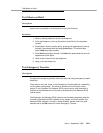
Approved Grounds
A-2 Issue 1 September 1995
encased ground, or a ground ring. If these grounds are not available, the water
pipe ground can be supplemented by one of the following types of grounds:
■ Other local metal underground systems or structures — Local
underground structures such as tanks and piping systems
■ Rod and pipe electrodes — A 5/8 inch (1.6 cm) (solid rod) or 3/4 inch
(1.9 cm) (conduit or pipe) electrode driven to a minimum depth of 8 feet
(2.5 meters)
■ Plate electrodes — Must have a minimum of 2 square feet (0.6 sq. meter)
of metallic surface exposed to the exterior soil
Concrete Encased Ground. — An electrode encased by at least 2 inches
(5 cm) of concrete and located within and near the bottom of a concrete
foundation or footing in direct contact with the earth. The electrode must be at
least 20 feet (6 meters) of one or more steel reinforcing bars or rods 1/2 inch
(1.3 cm) in diameter, or at least 20 feet (6 meters) of bare, solid copper,
4 AWG wire.
Ground Ring. — A buried ground that encircles a building or structure at a
depth of at least 2-1/2 feet (0.8 meter) below the earth's surface. The ground ring
must be at least 20 feet (6 meters) of 2-AWG, bare, copper wire.
Approved Floor Grounds
Approved floor grounds are those grounds on the floor of each high-rise building
suitable for connection to the ground terminal in the riser closet and to the Private
Branch Exchange (PBX) equipment single-point ground terminal. Approved floor
grounds may include the following:
■ Building steel
■ The grounding conductor for the secondary side of the power transformer
feeding the floor
■ Metallic water pipes
■ Power feed metallic conduit supplying panel boards on the floor
■ A grounding point specifically provided in the building for the purpose
!
WARNING:
If the approved ground or approved floor ground can only be accessed
inside a dedicated power equipment room, then connections to this ground
should be made by a licensed electrician.
NOTE:
All protective grounds must be electrically connected together to form a
single grounding electrode system.


















